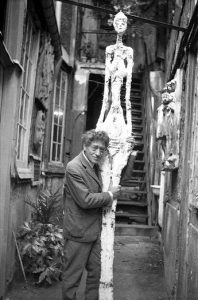Giagometti’s thinster sculptures give a physical form to the ephemeral spirit of the City of Love, argues Vivien Lash.
We’ll always have Paris, as Bogart said to Bergman. But while old boyfriends grow a gut, the City of Love remains its neo-classical self. It’s always there for you when you want it or need it, thanks to Napoleon, who hired Baron Haussmann to reinvent its medieval streets as a stage for a procession of artists and models to show off on.
A city is defined by its atmosphere as well as its architecture, and Paris’s past mingles with its present. Marie Antoinette and Oscar Wilde could be drinking champagne from the same cup as F. Scott Fitzgerald and Picasso. Add a little absinthe and turn it into a car crash.
New York City, Tokyo, Beijing have been art capitals more recently than Paris, but the streets of Le Marais still echo with the footsteps of surrealism. Alberto Giacometti, one of the artists associated with that dead-glam world that was Paris between the wars, is now showing at London’s National Portrait Gallery (until January 10, 2016).
I’ve loved his thinster sculptures since — literally — bumping into one of them at the Port Lligat Hotel overlooking Salvador Dali’s house in Spain, while trying to dodge one of those gigantic flies dressed by Balenciaga. “He used to stay here,” the owner, Gala Dali’s bestie, told me, “and he left that behind.” A bronze gift to pay his hotel bill?
Born into a wealthy Swiss family, Giacometti ran away from all those clocks to Paris to be an artist, using a femme de la nuit as his model, like Toulouse Lautrec before him. French prostitutes effortlessly captured that consumptive-chic look that still gets reinvented on the catwalk every season. You have to love a sculptor who makes his models even thinner, sticking the paintbrush up to Rubens and his saggy fat burds who all seem to be suffering from irritable bowel syndrome.
Giacometti shared a claustrophobic hotel room/studio with his brother Diego, the atmosphere of which the NPG show is designed to recreate, down to the details of daylight and twilight. This is only possible with corporate sponsorship and popular recent shows like Audrey Hepburn keeping the crowds in the gift shop. Holly Golightly hat anyone? Giacometti fridge magnet? Or, mysteriously, a box of sugar-free chocolate mints.
Memory is not defined by fact so much as atmosphere. It’s possible, walking through the four rooms of the show, to experience a memory of something you have not witnessed — especially when looking at the last bronze, Diego Seated, which Giacometti worked on as he was dying. This figure radiates loneliness to the voyeur in a 21st-century world where the desire to consume has overtaken the need to create.
Before marrying Mr. Lash I was a Morin, the French equivalent of Smith. I grew up with the myth that my ancestors had come to Scotland with Mary Queen of Scots when the child bride came home after the death of the dauphin, escaping her mother-in-law Catherine de Medici, but ending up with her head chopped off. My dad, an early-period Alain Delon type, added alcohol to the flames of myth by singing Thank Heaven for Little Girls in his best Maurice Chevalier impersonation and my grandmother joined in, giving me a long string of flapper pearls and a vintage Chanel riding jacket to wear instead of my school blazer.
Imagine my perverse delight when it turned out that the Morins are from the bogs of Derry. My great-grandfather changed his name on the boat from Londonderry to Glasgow, converting the Irish Moran into the French Morin. Was he a social climber, eager to offload the stench of potatoes that grow in the dark like the devil’s wee friends? Maybe he couldn’t spell.
This news didn’t stop my brother and I from running away to Paris every time we were bored. While he worked as a beggar outside Galeries Lafayette, living under Pont Neuf before it was fashionable, I was briefly a model, having been ‘discovered’ wearing PVC in St. Denis in my ironic prostitute-chic phase. But I’m shallow not stupid and my attention span is too short to pose for pictures.
In heaven, Giacometti had the last laugh over poverty and cramped hotel rooms with his Walking Man bronze breaking world records to sell for $65 million. Things need to change in order to stay the same. Art becomes more valuable or it disappears. But Paris stays the same; it’s you that’s different, climbing the steps to Sacre Coeur in the rain.


